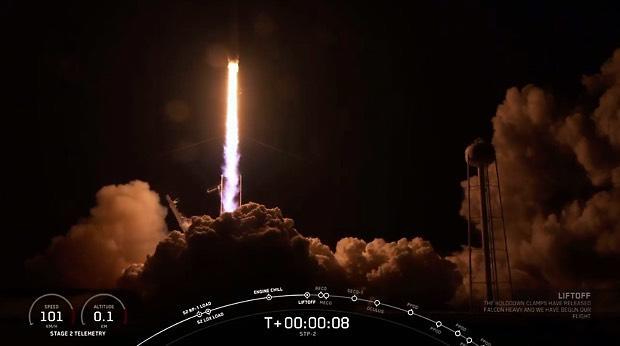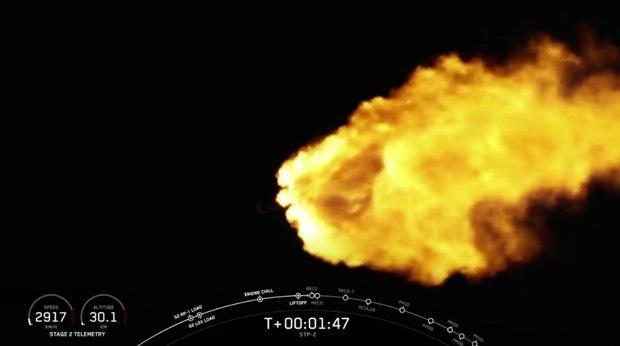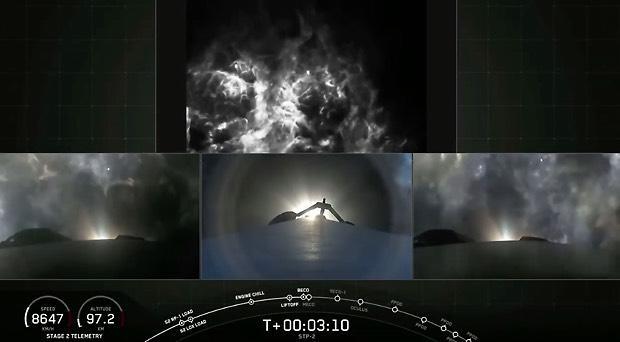SpaceX Falcon Heavy makes dramatic early morning launch
A triple-core SpaceX Falcon Heavy rocket making the booster's third flight -- its first at night -- streaked into space Tuesday morning with a sky-lighting plume of fiery exhaust, a spectacular send off for a complex $750 million mission to deploy 24 small science and technology testbed satellites into multiple orbits for the Pentagon, NASA and a variety of other agencies.
Thrilling area residents and tourists who stayed up to catch the delayed 2:30 a.m. EDT liftoff, the rocket put on a dazzling show, lighting up the overnight sky for miles around with its 27 first stage engines belching rushing jets of flame.
Then, as it was fading from view, the Falcon Heavy's two previously-flown side boosters peeled away, flipped around and descended to side-by-side rocket-powered touchdowns at the Cape Canaveral Air Force Station, triggering window-shaking sonic booms.
The Falcon Heavy's central core stage, making its first flight, fired about a minute longer than its two sidekicks before it, too, shut down and fell away. Without enough left-over propellant to make it back to Florida, it headed instead for landing on a SpaceX drone ship -- the "Of Course I Still Love You" -- stationed more than 700 miles to the east of Cape Canaveral.
But it didn't make it. Considered a bit of a long shot given the requirements of the payload's initial orbit and the distance from the launch pad, the core rocket appeared to crash onto or near the landing ship. With the two successful recoveries, SpaceX's record now stands at 43 successful booster landings, 17 on land and 26 on droneships.
The rocket's second stage, meanwhile, pressed ahead toward an initial orbit, the first of three required by the multi-satellite payload.
Managed by the Air Force Space and Missile Systems Center, the Space Test Program 2 -- STP-2 -- mission marked the Pentagon's first use of a SpaceX Falcon Heavy rocket for "one of the most challenging missions the Space and Missile Systems Center has ever launched," said Col. Robert Bongiovi, director of the Air Force Launch Enterprise Systems Directorate.
"We're putting 24 research and development satellites into three separate orbits, with a first-ever four engine start and burn of the second stage."
In so doing, the third flight of the Falcon Heavy, using two previously flown boosters, will help certify the powerful rocket for launching expensive high-priority national security payloads, a major milestone for SpaceX.
"The use of the previously-flown hardware is providing critical insight into reusability and quality assurance that will allow us to provide space access to the warfighter in a more cost-effective and expedient manner," Bongiovi said. "I really appreciate the efforts of our industry partner (SpaceX) to make this happen."
Stacked in a dispenser inside the Falcon Heavy's nose fairing, the STP-2 payloads included an ultra-accurate atomic clock that NASA is testing to improve deep space navigation; six satellites sponsored by the National Oceanic and Atmospheric Administration and Taiwan that will help improve tropical weather forecasting; and experimental propulsion technology provided by NASA that uses less-toxic but more powerful "green" propellants.
Other payloads, several built by students, will study how Earth's magnetic field and charged particles in the near-space environment affect sensitive electronics and communications. Twelve small "Cubesats" are on board, including one provided by the Planetary Society to test solar sail technology, using the pressure of sunlight for propulsion.
Packed into a three-unit Cubesat the size of a loaf of bread, the solar sail will unfurl to the size of a boxing ring and, if all goes well, catch enough sunlight to climb up to three tenths of a mile per day without the use of traditional thrusters and propellant.
"It's really a romantic notion that has tremendous practical applications," said Bill "The Science Guy" Nye, CEO of the Planetary Society, said before launch. "We share the technology with the world, and we are very excited about this launch because we're going to get to a high enough altitude ... that we're really going to be able to build orbital energy and take some, I hope, inspiring pictures."
Also on board for the STP-2 mission: small portions of the cremated remains of 152 space enthusiasts being sent into orbit by their families through Celestis Memorial Spaceflights, a company that provides launch opportunities for clients who opt for burials in space and what the firm's website describes as "a uniquely compelling memorial experience."
Originally scheduled for launch at 11:30 p.m. Monday, the flight was delayed for three hours to allow more time for "additional ground system checkouts," SpaceX said in a tweet. But at 2:30 a.m., all systems were go, and the 229-foot-tall rocket, the most powerful operational booster in the world, blasted off atop more than five million pounds of thrust.
Quickly climbing away from historic pad 39A at the Kennedy Space Center -- the same pad used by the Apollo 11 moonship 50 years ago next month -- the Falcon Heavy smoothly arced to the east over the Atlantic Ocean, rapidly accelerating as it consumed propellants and lost weight.
After pushing the rocket out of the thick lower atmosphere, the two side boosters separated, flipped around and fired three engines each to reverse course. Then, falling back into the discernible atmosphere, the engines briefly re-ignited to slow the vehicles down and titanium grid fins at the top of each rocket began actively steering and maintaining a stable orientation.
Finally, as they plummeted toward two SpaceX landing pads at the Air Force station, each rocket fired up a single engine, landing legs deployed and both settled to picture-perfect touchdowns in an increasingly familiar display of precision guidance. The central core stage came close to executing a similar feat but fell just short.
It was the first night launch and landing for the Falcon Heavy, the first use of the Heavy by the Air Force and its first use of previously flown booster hardware. The mission was especially complex because the satellites were bound for three different orbits, requiring multiple firings of the Falcon's single second stage Merlin engine.
In an initially elliptical orbit measuring about 186 by 534 miles, the dispenser released a satellite known as Oculus 13 minutes after launch. Built by students at the Michigan Technological University, Oculus will serve as a target to test techniques for studying satellites from the ground. Eleven Cubesats also were to be deployed from the dispenser between 19 and 50 minutes after takeoff.
The second stage then was expected to fire again to circularize the orbit at an altitude of about 447 miles before deploying General Atomics' Orbital Test Bed satellite, housing NASA's atomic clock and the Celestis cremains, the green propellant experiment, a Naval Research Laboratory space weather monitor and the six satellites making up NOAA's COSMIC 2 payload.
The second stage had to fire twice more to achieve an orbit with a high point of around 7,455 miles and a low point of about 3,700, in the process changing the tilt of the orbit with respect to the equator. At that point, the Air Force's Demonstration and Science Experiments -- DSX -- satellite could be deployed to characterize the space radiation environment and its effects on sensitive electronics.
"On the scale of complexity of launches that we do in the National Security Space Launch program, this is on the complex edge," said Bongiovi. "We're going to see a lot more multi-mission (launches), a lot more of the multiple drop-offs, those kind of things, so it's actually really good that we have such a complex mission on this experimental launch."







